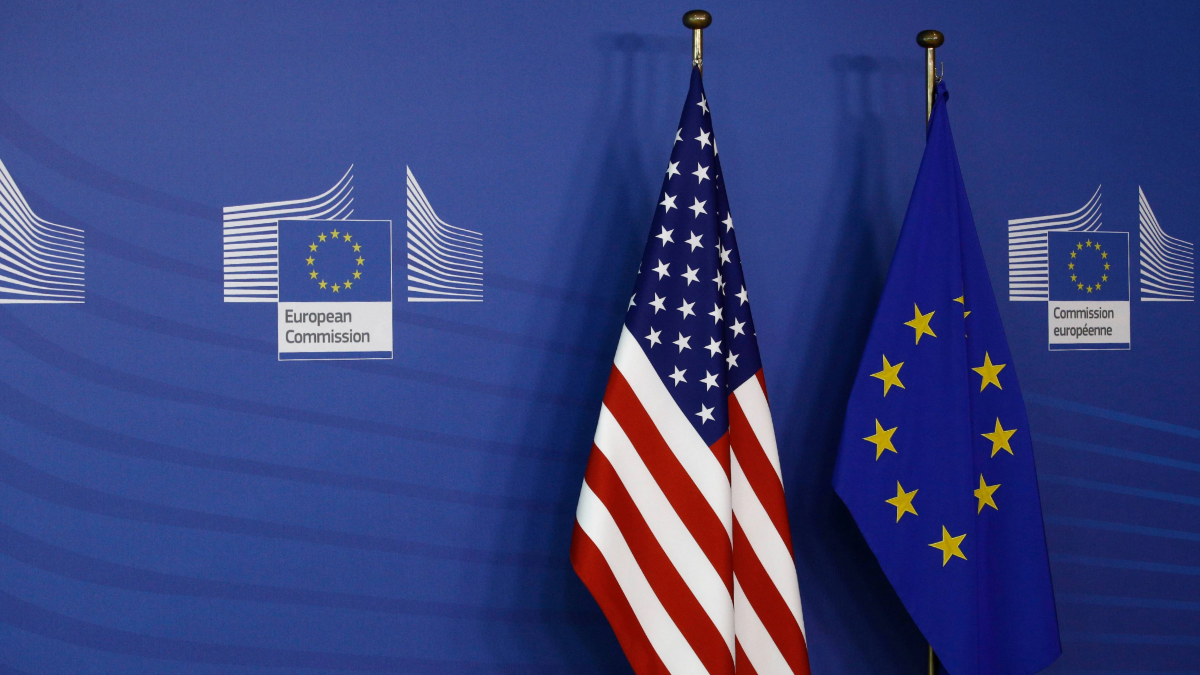Recapping Key Shifts in the US-EU Transatlantic Ties in Trump's First 100 Days
Filip Kulakov / May 2, 2025Filip Kulakov is a Georgetown University McCourt School of Public Policy, Tech and Public Policy Fellow with Tech Policy Press.
As US President Donald Trump and his administration conclude the first 100 days of his second term, transatlantic relations—particularly in the area of tech regulation—remain a key focus. While longstanding allies, the US and the European Union (EU), increasingly find themselves at odds over the regulation of digital markets and American tech companies. The growing unpredictability of the transatlantic relationship is becoming particularly costly to US tech companies, as European governments and companies seek to reduce their reliance on American technology.
Clash Over EU Tech Regulation Enforcement
In the aftermath of the US election and ahead of President Trump’s inauguration, the European Union began reconsidering its enforcement approach toward major US-based tech companies under the Digital Markets Act (DMA) and Digital Services Act (DSA)—key pillars of the EU’s competition and online safety frameworks. These decisions occurred amidst criticism from the President and other US policymakers of EU tech regulations, including likening them to a “form of taxation” on American companies, while portraying the DSA as a “restriction on free speech.”
US-based tech companies have also advocated for the Trump administration to contest EU regulations, including describing the DMA as “discriminatory.” The disagreement has sparked a flurry of official correspondence between Washington and Brussels, with the US urging deregulation and the EU defending its laws as fair and necessary for market accountability, not punitive measures against American companies.
In mid-February, the White House issued a memorandum aimed at protecting US-based tech companies from what it viewed as unfair treatment in foreign jurisdictions, as well as potential actions that can be pursued. The EU, for its part, has warned that if the Trump administration takes punitive measures against the bloc, it will respond “swiftly and decisively.” Following the White House's imposition of tariffs on April 2, the EU explicitly stated that it will not blur the lines between trade talks and discussions on tech regulation.
These ongoing tensions however, did not deter the EU from proceeding with the enforcement of its regulations, as it took action against Apple and Alphabet, finding them in non-compliance with their tech laws, and fining them €500 million and €200 million respectively in late April. US officials condemned the fines, describing them as a “form of economic extortion.”
Movement Towards European Digital Sovereignty
Even before President Trump’s second term began, Europe had been pushing to reduce its reliance on US technology—a movement that gained urgency in the first 100 days of the new administration. With transatlantic tensions rising over tech regulation and US policy uncertainty, the EU doubled down on its commitment to “strengthen its digital sovereignty and set standards,” focused on data, infrastructure, and technology.
In addition, a coalition of organizations has called on EU officials to make a “strong commitment to sovereign digital infrastructure,” supporting the EuroStack initiative—a European tech infrastructure project aimed at building local capacity across digital value chains, from chips to data, computing, and connectivity. As the reliability of the US-EU relationship comes into question, European governments and companies are seeking EU-based alternatives. Cloud service providers such as Swiss-based Exoscale and Swedish-based Elastx have reported increasing demand for their services, as more European businesses look to reduce their dependence on US technologies.
Pivot in AI Regulation?
Trump’s second term coincided with EU efforts to ease regulatory burdens on AI, in line with the recommendations from the Draghi report on EU competitiveness. At the AI Summit in Paris, the US Vice President criticized the EU AI regulation as “excessive” and “hindering the development of the AI industry.” In a moment of alignment, EU Commission President von der Leyen acknowledged the existing regulatory hurdles and stated the need to further “cut red tape.”
Henna Virkkunen, the EU Commissioner for Technological Sovereignty, Security, and Democracy, also pledged to conduct a “fitness check” of EU tech laws and identify areas where they can be simplified. Possibly, in line with these efforts, the EU withdrew its AI Liability Act from consideration, which aimed to regulate “damage caused with the involvement of AI systems”—and signaled that revisions to other tech regulations are also under consideration.
Still, deepening disputes over digital market rules, content governance, and digital sovereignty may continue to strain the transatlantic relationship, even as Trump may be reconsidering his approach to tariffs. The durability of cooperation is increasingly uncertain, as the US maintains its support for domestic companies, while the EU safeguards its legal and regulatory framework. The question remains whether the growing divergence in US-EU tech policy is a temporary rift or a sign of a more permanent realignment.
Authors

